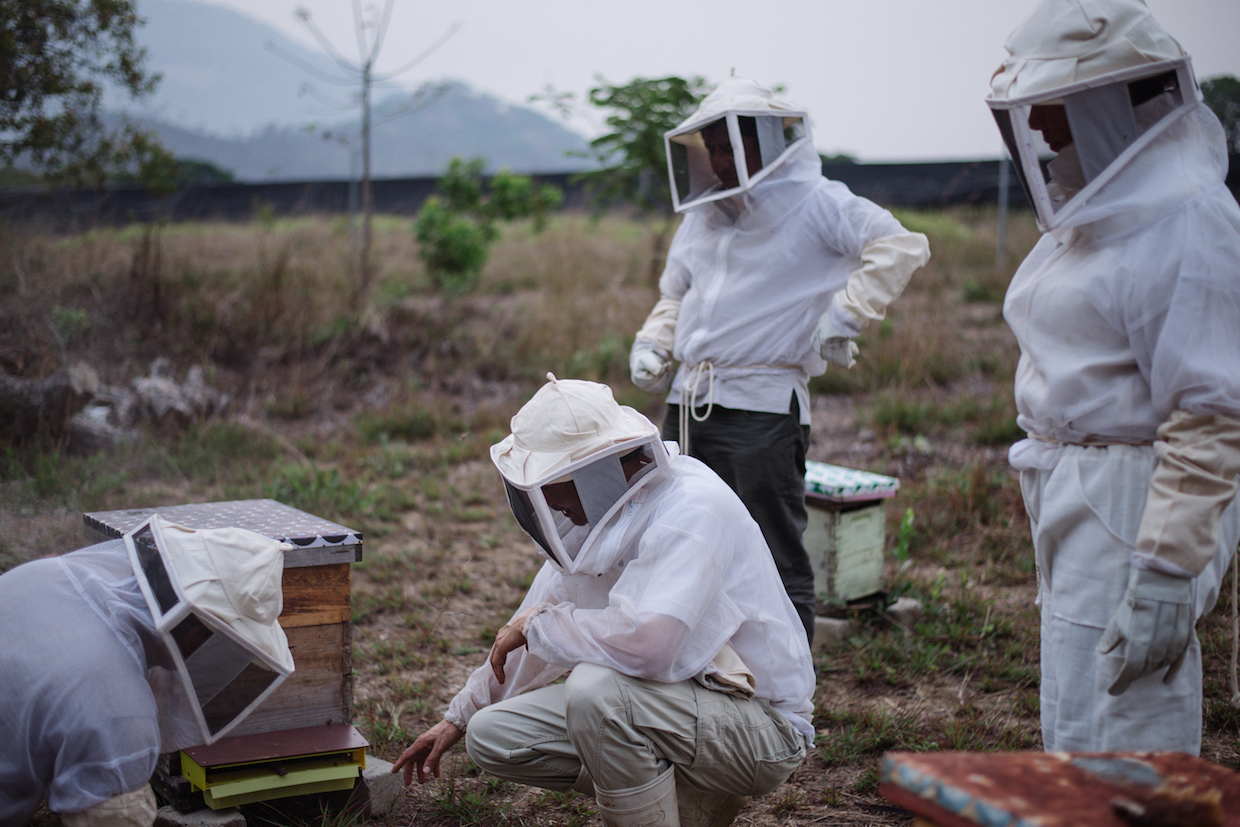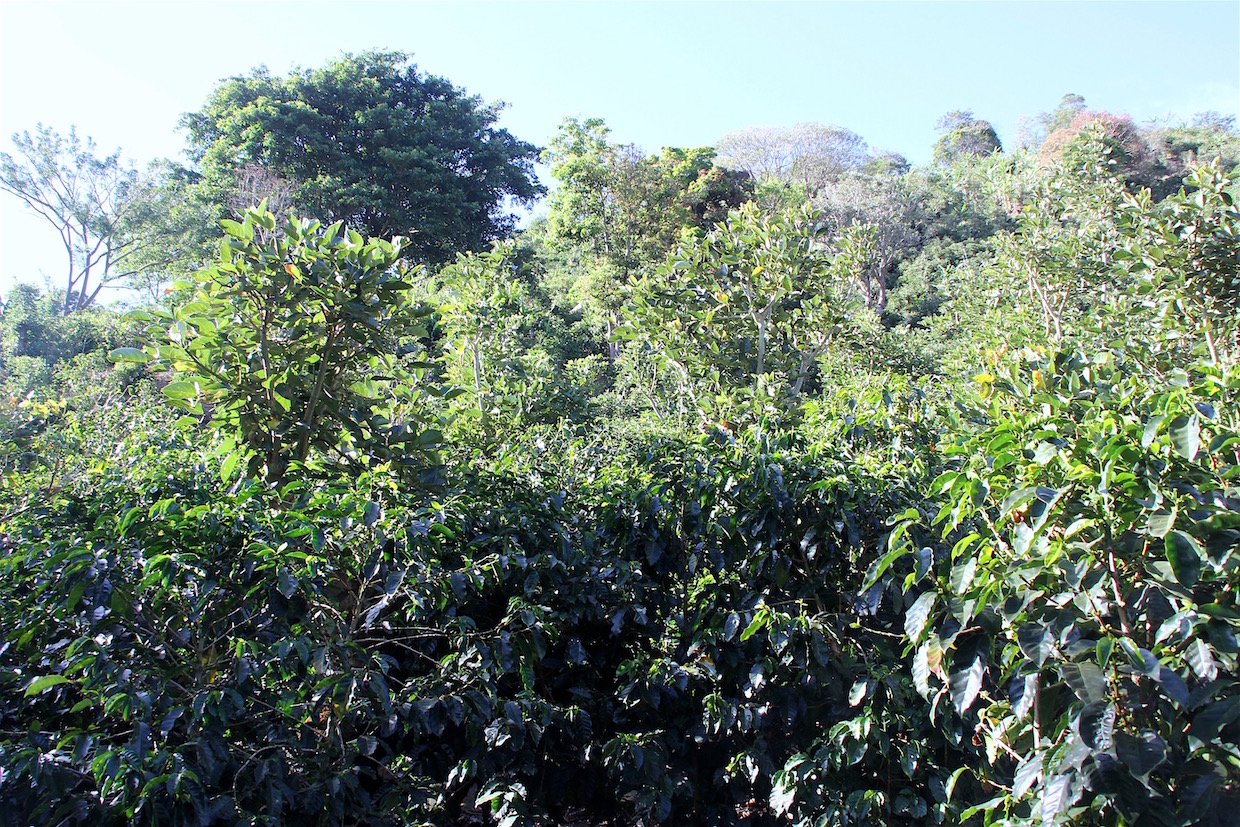
Learning communally during the first year reduces attrition among new beekeepers, who are working with aggressive Africanized bees. Photo by Julia Luckett Photography, courtesy of Food 4 Farmers.
As the scientific community reminds us, there’s plenty to be concerned about regarding the sustainability of coffee as an agricultural product.
We published dozens of columns on coffee sustainability this year, covering elements from seed to cup. Nearly all these columns focused on one specialized area, providing practical advise or impassioned pleas to help improve the life of coffee bit by bit.
Of course, prices and producer income were huge issues this year. But there was also climate change — which in many coffee-growing regions is no longer a looming spectre; it is a new reality. We also published columns from some of the sustainability sector’s leading minds on topics including: the potential of shade coffee; GMOs and coffee; the importance of healthy soil; the power of bees; and a potential anonymous transaction guide.
Here are some of our best columns on coffee sustainability in 2018:
Envisioning the Future of Shade Grown Coffee
As we consider the future of coffee, we should consider shade grown coffee in terms of viability and sustainability. Coffee should be grown within a landscape incorporating shade trees when, and where, it is viable, both environmentally and economically — including considerations such as elevation, temperature, and slope, etc. — while also conserving forested areas, protecting watersheds and highly erodible hillside areas, and practicing selective and regulated harvesting of trees for fiber, fuel, and lumber for the surrounding communities.
Understanding GMOs: Genetic Engineering and the Future of Coffee
Coffea arabica is a fastidious shrub. With the exacting terroir, heritage and willing producer to invest the time and energy into cultivating this delicate commodity, it will produce generous rewards. This shrub is grown in conditions that mimic its endemic origin of Ethiopia. Presently, coffee is grown in a region within 25 degrees latitude north to 30 degrees latitude south of the equator, colloquially referred to as the coffee belt. Within this belt, approximately 25 million people are involved in the production of coffee, all of whom are vulnerable to the consequences of climate change.
Despite two decades of efforts by “Third Wave” roasters and coffee enthusiasts, as well as thousands of good faith initiatives to pull coffee away from the commodity trap, it seems that we have not made much progress. This is particularly disappointing in the face of impressive industry growth, both in volume and, even more so, in revenue.
The Seven Cardinal Sins of Coffee Sustainability
I am an eternal optimist. You have to be in this line of work — protecting the future of coffee is tireless work, and it can feel like once we’ve solved one challenge in one place, then a dozen more bubble up. Taking time to count the successes and keeping up hope that the work we do adds up to something is the only way to survive.
The Time to Regenerate Coffee is Now, and it Starts with Healthy Soil
It is time to move beyond the idea of sustainable coffee. Sustaining something assumes that what we have is already good enough. Yet numerous studies have shown that if the coffee industry does not change its current “business-as-usual” approach, we will not have quality coffee in the future. And this will hurt everyone that currently benefits from the sector — from farmers at origin to that coffee shop consumer who enjoys a specialty pourover from a distant tropical paradise.

Risaralda has a unique geography that is perfect for coffee production but vulnerable to climate change. Natalie White. CC BY-SA
Coffee Farmers Struggle to Adapt to Colombia’s Changing Climate
We asked 45 farmers questions that tapped into the farmers’ own conceptualization of climate change, such as “What is climate change?” and “How, if at all, has climate change affected you as a farmer?”
The results were stark.
Towards A Data-Backed and Anonymous Coffee Transaction Guide
Among the conversations was a focus on a pilot project that will produce a data-backed transaction guide for the specialty sector. This guide will ask industry participants to donate key information about their green coffee purchases from the last two harvests. Information on prices, quantity, quality and region will be anonymized and aggregated by researchers, with the goal of creating an alternate price discovery tool for the specialty coffee industry.
Things I’ll Never Do Again (Or, My Failures in Coffee Sustainability)
It is a bit cliché to say that we learn the most from our failures. But, of course, like most clichés, we repeat it because it bears some truth. Presuming we do learn most from our failures, and understanding how critical it is that we learn from one another, then by all means we should be sharing the stories of our failures, even if they are a little embarrassing.
Making the Case for Better Coffee through Bees
By now it’s common knowledge that bees are in jeopardy throughout the world. As agricultural practices have intensified and pesticide use has increased, bee populations are being decimated. New research exploring the effects of bee pollination on quality and quantity of coffee shows promise both for bees and coffee farmers.
McDonald’s May Not Be Saving the World, But It’s Doing Something (Anything) About Coffee
Say what you will about McDonald’s place as one of the world’s largest beef-production-related greenhouse gas emitters — and there’s plenty to say about that — but the company seems at least to be taking a baseline commitment to coffee sustainability seriously.
Nick Brown
Nick Brown is the editor of Daily Coffee News by Roast Magazine.








Comment